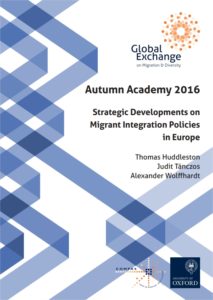This paper aims to present the major policy trends, the main drivers and future options for the integration of third-country nationals in Europe at the EU, national and local levels. Each policy area briefly introduces the state of play through a mapping of what is already known, presents the most important policy changes and trends and looks ahead to future development.
The increasing number of arrivals and the assumption that the Common European Asylum System is in crisis has accelerated changes in the area of migration and integration, with a rapidly transforming European and national legal frameworks and a growing number of local and regional initiatives. Firstly, the paper presents recent trends and developments at these three governance levels and shows where the focus of the integration debate falls within these levels. Then, it turns to the assessment of the two major European legal migration channels, resettlement and family reunification and analyses their links and impacts for integration. The third chapter presents the major policy areas that are currently the focus of reform efforts on migrant integration. This section points to possible gaps and risks as well as opportunities for innovation in the fields of voluntary initiatives, language and integration obligations, labour market integration as well as refugees’ reception conditions, qualification and targeted integration policies. The chapter mainly draws conclusions from the Migrant Integration Policy Index (MIPEX) and international comparative research in order to put European developments into context. The last chapter introduces policy areas that are currently at the margins of integration policy debates but potential drivers of longterm change: active citizenship, anti-discrimination and mainstreaming integration.
The current reforms are drafted with the objectives of reducing refugee arrivals and incentives for secondary movements while at the same time preserving or increasing an individual’s integration prospects. These dual objectives can lead to major policy contradictions, which are summarised in the concluding part of the paper, together with the challenges to establish multilevel governance on integration.
Strategic Developments on Migrant Integration Policies in Europe


0 thoughts on “Strategic Developments on migrant integration policies in Europe”